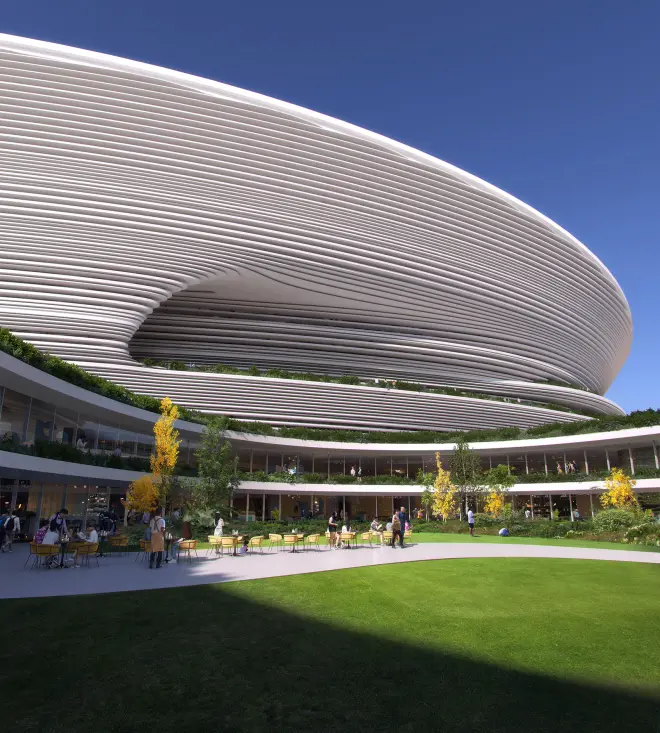赢得了杭州国际体育中心的设计竞赛 | 扎哈·哈迪德建筑事务所

扎哈·哈迪德建筑事务所(ZHA)赢得了杭州国际体育中心的设计竞赛。
杭州国际体育中心设计内容包括:一座可容纳6万位观众的足球场和练习场、一座包含1.9万个座位的室内体育场,以及一座可提供两方50米标准泳池的水上运动中心。项目位于杭州未来科技文化区,落成后的体育中心将为城市带来全新的滨江公园和公共广场,并直接连接到杭州地铁3号线和5号线,融入城市不断发展的地下交通网络中。
Zaha Hadid Architects (ZHA) has won the competition to design the new Hangzhou International Sports Centre.
Incorporating a 60,000-seat football stadium and practice pitches, the Hangzhou International Sports Centre’s design also includes a 19,000-seat indoor arena as well as an aquatics centre with two 50-metre pools. Located within Hangzhou’s Future Science and Technology Cultural District, the sports centre establishes a new riverfront park and public plazas with direct access to Lines 3 and 5 of the city’s expanding metro network.
▼项目概览,Overall view ©Render by BrickVisual

作为世界领先的电子商务城市之一,杭州是国内众多大型科技公司总部的所在地,吸引着全国各地的IT专业人士和企业家来此生活和工作。为了适应杭州日益增长的人口,国际体育中心旨为广大业余与专业运动员提供充分全面的基础设施。紧凑的场馆设计结合了合理的朝向以及功能组成,使得近一半的场地转变为全新的城市公共空间。体育中心的设计融入了当地的城市规划以及河岸的自然景观,为市民创造出全新的城市公园以及各种集活动、娱乐和放松于一体的社交聚会场所。
One of the world’s leading centres of e-commerce, Hangzhou is home to many of China’s largest technology companies which attract IT professionals and entrepreneurs from across the country to live and work in the city. Accommodating Hangzhou’s growing population, the International Sports Centre’s design provides a variety of facilities for grassroots players to professional athletes. The compact design of each venue, together with their orientation and composition, allows almost half of the site to be transformed into new public spaces for the city. Integral to the district’s urban plan and the natural landscapes along the riverbank, the centre incorporates new parks and gathering places for events, recreation and relaxation.
▼鸟瞰,Aerial view ©Render by Plomp

足球场作为中心内最大的场馆,面积达135000平方米。它坐落于公园的东侧,面向城市开放。室内场馆以及游泳中心则位于足球场的西侧与南侧,三者之间通过分层平台相互连接。分层平台的设计灵感来自于杭州周边山坡上的茶园梯田,占地45000平方米的平台裙楼容纳体育中心的附属设施,包括:训练室、健身房、更衣室、办公室、商店、餐厅,以能够欣赏到平台庭院以及露台景观的咖啡馆。
As the largest venue within the centre, the 135,000 sq.m football stadium is situated on the eastern side of the new park to face the city. Located to the west and south of the stadium, the indoor arena and aquatics centre are connected to the stadium by the centre’s layered podium that weaves through the site.
Informed by the terracing of the tea farms on Hangzhou’s surrounding hillsides, the striated 45,000 sq.m podium houses the sports centre’s ancillary facilities that are shared between the venues including training and fitness halls, locker rooms, offices as well as shops, restaurants and cafes overlooking the podium’s courtyard and terraces.
▼体育中心包括足球场、室内体育馆和水上运动中心,Hangzhou International Sports Centre incorporates a football stadium, an indoor arena as well as an aquatics centre © Proloog

▼建筑外观,Exterior view © Proloog

与大多数体育场场的封闭式外观不同,杭州国际体育中心体育场的外立面是开放的,由百叶保护的露台上点缀了各种餐饮空间,在这里,人们可以看到整个城市的优美全景。
根据国际足联制定的标准设计,体育场座位席应使观众尽可能接近比赛场地,确保每个座位都享有优质的、不受任何遮挡的观赛视野,进而为球场上的球员和坐在观众席中的球迷都创造出激烈的比赛氛围。这些对于功能的需求与标准,自然定义了体育场的几何形态,并通过流畅起伏的立面百叶表达出来。
Unlike the solid façades of most stadiums, the façade of the Hangzhou International Sports Centre’ stadium is open to the exterior with louvres sheltering terraces that host a variety of food and beverage outlets offering panoramic views across the city.
Designed to FIFA standards, the stadium’s seating bowl is configured to bring spectators as close as possible to the field of play and ensure excellent, unrestricted views from every seat; creating an intense matchday atmosphere for players on the pitch and fans seated throughout the stadium. These programmatic requirements define geometries that are expressed as undulations within the louvred façade.
▼按照国际足联标准设计的体育场,The stadium designed to FIFA standards ©Render by BrickVisual

体育场的百叶立面模糊了室内外的界限。从近处观看,百叶的独特材质与精致细节为建筑赋予了一种如地质结构般分层的坚实外观;而从远处眺望时,由百叶构成的建筑立面则变得透明轻盈,将呈“碗”状的体育场观众席下部的公共空间与城市连接起来。
The stadium’s louvred façade blurs the boundary between interior and exterior. The louvres’ materiality and detailing give the stadium a stratified, geological appearance of solidity when viewed from nearby. When viewed from a distance, the louvred façade becomes transparent, connecting the public spaces beneath the stadium’s seating bowl with the city.
▼体育场的百叶窗立面模糊了室内外的界限,The stadium’s louvred façade blurs the boundary between interior and exterior © Render by Plomp

室内场馆面积74000平方米,能够容纳19000名观众,可作为独立的公共设施为公共服务。在设计上,该室内场馆具有最大的操作灵活性,除了大型音乐会和文化活动外,还可以举办篮球等众多国内最受欢迎的比赛项目。
水上运动中心位于公园西侧,占地15000平方米,该中心设有两方具有50米赛道的标准泳池,十分适合各类比赛、训练以及教学,能够满足从初学者到游泳精英再到跳水运动员的不同需求。游泳馆可容纳多达800名观众,既可以举办区级竞技赛事,也可以承办当地学校课程,确保成千上万的孩子每周都有学习游泳这项基本生活技能的机会。
With a capacity of 19,000 seats, the 74,000 sq.m indoor arena can operate independently to the stadium and is designed with maximum operational flexibility to host many of China’s most popular spectator sports such as basketball in addition to large music and cultural events.
Situated on the western edge of the park, the 15,000 sq.m aquatics centre incorporates two 50-metre pools suitable for competitions, training and teaching at all levels from beginner to elite swimmers and divers. Accommodating district-level competitive events with up to 800 spectators, the pools can also host local schools for lessons, ensuring many thousands of children each week will learn the essential life-skill of swimming.
▼大厅空间,Lobby © Render by Atchain

国际体育中心地处杭州的暖温带气候中,其设计达到了中国绿色建筑项目的最高三星级标准,每座场馆在一年中的大部分时间内都使用自然混合通风来提供最佳条件。立面外部百叶窗的构成取决于对年度太阳辐射量的分析,光伏板则将为所有场馆收集太阳能发电。地面热交换和回收系统将确保所有设施的最有效运作。
Located within the warm temperate climate of Hangzhou, the International Sports Centre has been designed to the highest 3-Star rating of China’s Green Building Program with each venue providing optimal conditions using natural hybrid ventilation most of the year. Annual solar irradiation analysis has determined the composition of the façade’s external louvres while photovoltaics will harvest solar power for all venues. Ground heat exchange and recovery systems will ensure the most efficient operations of all facilities.
▼裙楼容纳的设施在各场馆之间共享,The striated podium houses the sports centre’s ancillary facilities that are shared between the venues © Render by Proloog

体育中心的景观设计沿河岸建立了湿地,成为该地区排水网络中不可或缺的一部分。该网络收集和引导雨水和灰水,以进行过滤和重新使用,同时利用该地区原生的水生动植物,以自然的方式清除污染物。
为了减少整个项目的隐含碳,ZHA的优化过程最大程度地减少了结构所需的材料数量,并与当地的供应链和采购系统相结合,以增加被回收和可回收的部分。
The centre’s landscaping establishes wetlands along the riverbank that are integral to the district’s drainage network. Collecting and channelling rain and grey-water for filtration and re-use, this network uses aquatic flora and fauna native to the region to naturally remove contaminants.
To reduce the embodied carbon throughout the project, ZHA’s optimization processes minimise the amount of materials required for the structure and are integrated with local supply chains and procurement systems that have been developed to increase the recycled and recyclable content.
▼体育中心与湿地,View from the wetland © Render by Proloog

相比于多数功能单一、只在比赛日对游客开放,在非使用时间则沦为城市结构的“障碍物”的大型体育场,杭州国际体育中心为大众提供了多样的体育、娱乐和休闲设施,加上它外部的公共广场与河滨公园,确保该中心将成为受社区喜爱的全天候集会场所。
In contrast to the single-use programming of most large stadiums that only welcome visitors on match days and act as an obstruction to the city’s urban fabric when not in use, the many varied sporting, recreational and leisure facilities of Hangzhou International Sports Centre, in addition to its public plazas and riverfront park, ensure the centre will be a popular gathering place for its community throughout each day and evening.
▼建筑夜景效果图,Night view © Render by Proloog

Project Team
Architects: Zaha Hadid Architects (ZHA)
Design: Patrik Schumacher
ZHA Project Director: Charles Walker, Nils Fischer
ZHA Project Associate: Jakub Klaska, Lei Zheng
ZHA Competition Team: Joshua Anderson, Daniel Boran, Chun-Yen Chen, Hung-Da Chien, Michael Forward, Matthew Gabe, Rupinder Gidar, Jinqi Huang, Charlie Harris, Ivan Hewitt, Han Hsun Hsieh, Sonia Magdziarz, Xin Swift, Chris Whiteside
Consultants:
Sports Consultant: Clive John Lewis
Lighting: Lichtvision Design Ltd.
More:Zaha Hadid Architects。更多关于:Zaha Hadid Architects on zhuomei

